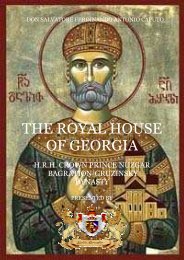here - Nobility Associations
here - Nobility Associations
here - Nobility Associations
Create successful ePaper yourself
Turn your PDF publications into a flip-book with our unique Google optimized e-Paper software.
dimension; yet it also had a more regional one. The alignment of cities on one side<br />
or the other reflected their rivalry with one another for power within their own<br />
area. Thus predominantly Guelf Florence opposed Ghibelline Siena, its major rival<br />
for influence in Tuscany .Below the regional level, the controversy had a local level<br />
which reflected the rivalry of powerful families. Thus within Florence Guelf-<br />
Ghibelline alignments were often based on considerations more familial than<br />
ideological.<br />
Five members of the Hohenstaufen family were kings of Sicily; Henry VI (1104-<br />
1197), Frederick II (1197-1250), Conrad II/V or Conradin (1254-1258) and Manfred<br />
(1259-1260). Manfred´s rule was limited to the Sicilian kingdom; the others were<br />
also kings of Germany and of the regnum Italicum, effectively north and central<br />
Italy. Only Frederick II was fully king of both countries; most of the lives of Henry<br />
VI, Conrad IV and Conradin were passed in Germany. Henry VI was in Italy only<br />
for the last three years of his life, Conrad IV in 1252-1254 and Conradin for less<br />
than a year in 1267-1268. Manfred was technically a usurper, becoming king only<br />
on receipt of the false news of Conradin´s death and refusing to relinquish the post<br />
when it was learnt the young king was still alive. Hohenstaufen rule over the<br />
southern mainland and Sicily effectively ended in 1255, when Charles of Anjou,<br />
brother of the French king Louis IX and summoned by Pope Innocent IV to assume<br />
the Sicilian crown, defeated and killed Manfred at the battle of Benevento. The<br />
brief and tragic reign of Conradin was only an epilogue. Summoned from Germany<br />
by the Italian Ghibellines, the seventeen year old boy was defeated by Charles at the<br />
battle of Tagliacozzo in Abruzzo, just inside the frontier of the Regno, and after a<br />
mock trial was beheaded at Naples by the victor on 29 October 1268.<br />
After the dead of the Emperor Frederick II, Pope Innocence IV left marks to<br />
destroy the “Svevi” (Swabian): “Never leave this man and his poisonous family the<br />
scepter with which dominated the people of Christ!” and, other terrible sentence:<br />
“Extirpate name, body, and seed of the heirs of the Babylonian”. Innocence died in<br />
1254. Under his successor Urban IV and Clemente IV, more rigid and obstinate,<br />
brought the destruction to them.<br />
Most of the Hohenstaufen sovereigns were thus primary kings of Germany and<br />
concerned with the maintenance of royal authority in that much divided land, but<br />
since the regnum Italicum formed part of the empire they had also to cope with the<br />
papacy and the communal movement in the north. The literature on these aspects<br />
of their history is huge and we will only describe those perspectives interested in<br />
the presentation of our family memoir.<br />
While the Swabian dynasty in the legitimate line became extinct with the death of<br />
Corradin (Corradino) in 1268, the illegitimate offspring which Federico Prince of<br />
Antioch, continued for many generations. T<strong>here</strong> are many descendants of Frederick<br />
The Hohenstaufen Dynasty - Page 11 of 200



